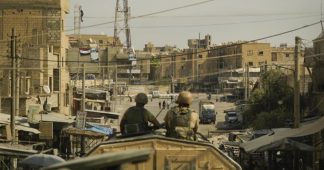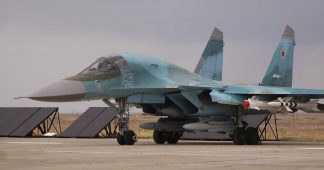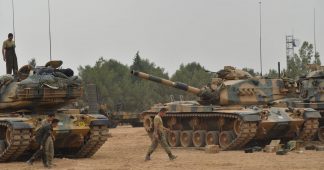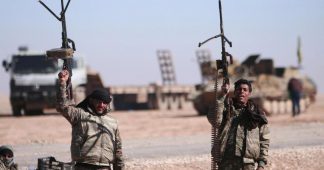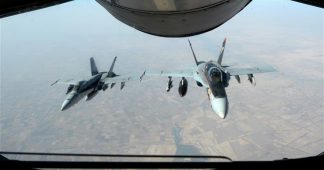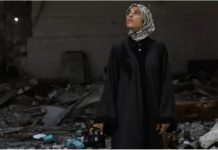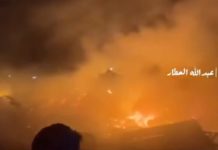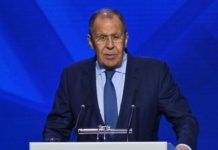By Bill Van Auken
9 February 2018
US warplanes and artillery batteries carried out an unprovoked massacre of up to 100 pro-government troops in the northeastern province of Deir Ezzor Wednesday, signaling the initiation of a new and far more dangerous stage in the more than three-year-old direct US military intervention in Syria.
The Syrian government denounced the attack as a “war crime” and “direct support to terrorism,” insisting that its forces came under US attack as they were carrying out an operation against Islamic State of Iraq and Syria (ISIS) elements between the villages of Khasham and al-Tabiya on the eastern side of the Euphrates River.
While the Pentagon proudly claimed to have killed 100 pro-government fighters, Damascus allowed that the US strikes claimed “the lives of dozens, injuring many others and causing massive damage in the area.”
The Syrian Observatory for Human Rights, meanwhile, said it had confirmed only 20 dead among the pro-government forces.
Whatever the precise number of casualties—the Pentagon’s figures are suspect given that the bombings and artillery barrages were not followed up by any ground attack—the incident marks a major escalation of US aggression against Syria, eclipsing the firing of 59 US cruise missiles last April in response to an unsubstantiated allegation of a chemical weapons attack in Idlib province.
The only previous US attack resulting in comparable bloodshed was the September 17, 2016 US airstrike against a Syrian army position near the Deir Ezzor airport, which killed 62 soldiers and wounded some 100 more. The Pentagon claimed that attack was the result of an “unintentional, regrettable error.”
This time around, the US military said that it was exercising its “inherent right of self-defense” in attacking the forces of a government whose territory American troops are occupying without either its consent or any mandate from the United Nations.
The official story from the Pentagon is that a column of 500 pro-government fighters, including tanks and artillery, had attempted to take control of territory east of the Euphrates River that had been seized by the so-called Syrian Democratic Forces (SDF), the US proxy ground force that is overwhelmingly dominated by the Syrian Kurdish YPG militia. It accused the government forces of launching “an unprovoked attack on a well-established SDF position,” where US Special Forces “advisors” who direct the Kurdish fighters were deployed.
Pentagon officials speaking on condition of anonymity told the media that they believed Russian military contractors operating with the Syrian government forces were among the dead.
The Russian Defense Ministry reported that it had no military personnel in the area. It also said it was aware only of 25 Syrian militia members having been wounded in the US strikes.
Russia’s Defense Ministry added in a statement that the American attack once “again showed that the US is maintaining its illegal presence in Syria not to fight the Daesh group [ISIS], but to seize and hold Syrian economic assets.”
The area where the fighting took place is a center of Syria’s oil and gas fields. The village of al-Tabiya is the site of the Conoco gas plant, which was previously run by ConocoPhillips until the energy corporation turned it over to the Syrian government in 2005. After the area fell under ISIS control, the Islamist militia used gas and oil exports to secure much of its financing.
Washington is determined to deny the Syrian government control over these resources and to that end has sought to carve out a US zone of control covering roughly 30 percent of the country, while cutting off its borders with Turkey and Iraq.
Russia’s Foreign Ministry raised pointed questions about the US version of events, particularly the vast disparity between the claim of 100 Syrian government troops killed and, on the other side, a total of one SDF fighter wounded.
“First of all, how could a 500-strong unit attack a headquarters with tank and artillery support and, as a result, inflict an injury on one counter-attacker?” asked Russian Foreign Ministry spokesperson Maria Zakharova. “How could those who were in that headquarters remain in those conditions for the half hour or more needed to call in and ensure air support?”
“How, within such a short period of time, could a decision have been made to open massive fire for effect on Syrian armed forces?” she continued. “To clarify all these questions, and to get a full picture of what happened, relevant information is now being gathered, both through our military experts and through the Foreign Ministry.”
Despite the words of protest from Moscow, the Pentagon reported that it had used its “deconfliction line” with the Russian military to provide advance notice of its strike on the Syrian government forces and remained in contact during and after the attack. “We had a very productive conversation,” said Pentagon spokesperson Dana White. “…we told them, they knew what was happening. They agreed not to attack Coalition forces. So, from that respect, it was successful.”
The attack on Deir Ezzor is part of a steady ratcheting up of the multisided conflict in Syria, provoked overwhelmingly by Washington’s announced decision to maintain a permanent US military occupation of the country and pursue a “post-ISIS” policy centered on the original US objectives of Syrian regime change and rolling back Iranian and Russian influence in the region. Until launching the anti-ISIS campaign in 2014, Washington had sought the ouster of the government of President Bashar al-Assad by means of supporting and arming the Al Qaeda-linked militias out of which ISIS itself emerged. This sparked the bloody seven-year-long war that has claimed the lives of some 350,000 Syrians, while displacing millions of others.
Since invading the country over three years ago, the US military has relied primarily on the Kurdish YPG as its proxy ground force, but it also continues to arm and train Islamist militia groups. During the US-backed siege of Raqqa and other formerly ISIS-occupied towns, the US military and its Kurdish proxies organized the evacuation of large numbers of ISIS fighters and their redeployment to Deir Ezzor in order to turn them against the Syrian government forces advancing on the province’s strategically vital oil and gas fields.
To the west, the Turkish invasion of the Kurdish-controlled enclave of Afrin, which came in response to US plans to organize a 30,000-strong “border security force” based largely on the Kurdish YPG and create what Ankara sees as a de facto Kurdish state on its border, threatens to escalate into a direct conflict between the US and Turkey, ostensible NATO allies.
On Wednesday, the top US commander in Syria and Iraq, Lt. Gen. Paul Funk, visited Manbij, the Syrian city on the western side of the Euphrates that has been occupied by the YPG and its US Special Forces handlers. The visit came just one day after Turkish President Recep Tayyip Erdogan demanded that the American forces withdraw from Manbij, vowing that the Turkish military would extend its offensive into the city.
Asked if he was worried about the Turkish threat, Gen. Funk responded, “It’s not in my job description to worry; my job is to fight.”
Meanwhile, both the US and French governments have issued condemnations of Damascus over bombings in Idlib province and Eastern Ghouta, as well as unverified allegations of using chlorine gas against civilian populations. The State Department issued a statement saying that the bombings “must stop now.”
The hypocritical Western media, which went largely silent as the US killed tens of thousands of civilians and razed entire cities to the ground in last year’s sieges of Mosul in Iraq and Raqqa in Syria, has suddenly woken up to report the civilian casualties resulting from the bombardments by Syrian and Russian warplanes. Once again they are churning out propaganda to prepare for a military escalation that has the potential of triggering a direct military confrontation between the world’s two major nuclear powers, the US and Russia.
